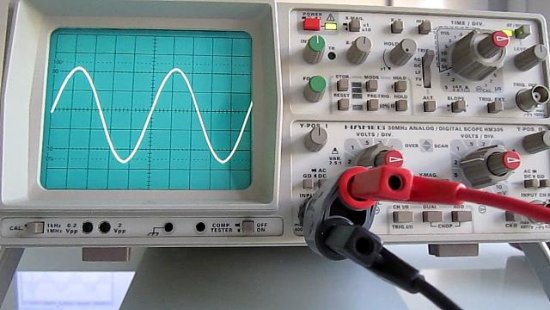Electricity
What is electric current
 Electricity — directed movement of electrically charged particles under impact electric field... Such particles can be: in conductors - electrons, in electrolytes - ions (cations and anions), in semiconductors - electrons and so-called "holes" ("conductivity of electron holes"). There is also a «bias current», the flow of which is due to the process of charging the capacitance, that is, from a change in the potential difference between the plates. No particle movement occurs between the plates, but current flows through the capacitor.
Electricity — directed movement of electrically charged particles under impact electric field... Such particles can be: in conductors - electrons, in electrolytes - ions (cations and anions), in semiconductors - electrons and so-called "holes" ("conductivity of electron holes"). There is also a «bias current», the flow of which is due to the process of charging the capacitance, that is, from a change in the potential difference between the plates. No particle movement occurs between the plates, but current flows through the capacitor.
In the theory of electric circuits, current is considered to be the directed movement of charge carriers in a conductive medium under the action of an electric field.
Conduction current (just current) in the theory of electrical circuits is the amount of electricity flowing per unit time through the cross section of a wire: i = q /T, where i — current. A; q = 1.6·109 — electronic charge, С; t — time, s.
This expression is valid for DC circuits. For alternating current circuits, the so-called Instantaneous current value equal to the rate of change of charge over time: i (t) = dq /dt.
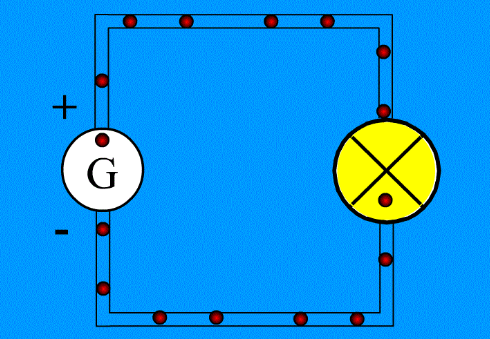
The first condition for the long-term existence of an electric current of the considered type is the presence of a source or generator that maintains the potential difference between charge carriers. The second condition is the closure of the road. In particular, for a direct current to exist, it is necessary to have a closed path along which charges can move in the circuit without changing their value.
As you know, in accordance with the law of conservation of electric charges, they cannot be created or destroyed. Therefore, if any volume of space where electric currents flow is surrounded by a closed surface, the current flowing in that volume must be equal to the current flowing out of it.
More on this: Conditions for the existence of electric current
The closed path through which an electric current flows is called an electric circuit or electric circuit. Electric circuit — divided into two parts: the inner part, in which electrically charged particles move against the direction of electrostatic forces, and the outer part, in which these particles move in the direction of electrostatic forces. The ends of the electrodes to which the external circuit is connected are called clamps.
So, an electric current occurs when an electric field appears on a section of an electric circuit, or a potential difference between two points on a wire. Potential difference between two points electrical circuit are called the voltage or voltage drop in that section of the circuit.
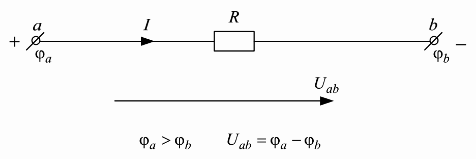 Instead of the term "current" ("current quantity"), the term "current strength" is often used.However, the latter cannot be called successful, since the current strength is not any force in the literal sense of the word, but only the intensity of movement of electric charges in the conductor, the amount of electricity passing per unit time through the cross-sectional area of the conductor.
Instead of the term "current" ("current quantity"), the term "current strength" is often used.However, the latter cannot be called successful, since the current strength is not any force in the literal sense of the word, but only the intensity of movement of electric charges in the conductor, the amount of electricity passing per unit time through the cross-sectional area of the conductor.
The current is characterized amperage, which in the SI system is measured in amperes (A), and current density, which in the SI system is measured in amperes per square meter.
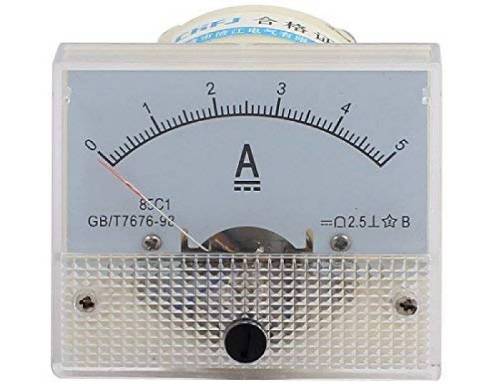 One ampere corresponds to the movement through the cross-section of the wire in one second (s) of a charge of electricity in the amount of one coulomb (C):
One ampere corresponds to the movement through the cross-section of the wire in one second (s) of a charge of electricity in the amount of one coulomb (C):
1A = 1C / s.
In the general case, denoting the current with the letter i and the charge q, we get:
i = dq / dt.
The unit of current is called the ampere (A).
Ampere (A) — the strength of a direct current which, when passing through two parallel straight conductors of infinite length and negligible cross-section, located in a vacuum at a distance of 1 m from each other, creates between these conductors 2·10-7 H for each meter of length .
The current in the wire is 1 A if an electric charge equal to 1 coulomb passes through the cross section of the wire in 1 s.
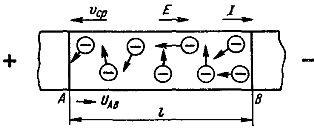
Rice. 1. Directional movement of electrons in a conductor
If a voltage acts on the wire, then an electric field arises inside the wire. With a field strength E, a force f = Ee acts on electrons of charge e. The quantities e and E are vector quantities. During the free path, the electrons acquire a directed motion along with a chaotic one. Each electron has a negative charge and receives the component of velocity opposite to the vector E (Fig. 1). The ordered motion, characterized by a certain average speed of the electrons vcp, determines the flow of electric current.
Electrons can have directed motion in rarefied gases. In electrolytes and ionized gases, current is mainly due to the movement of ions. Consistent with the fact that positively charged ions move from the positive pole to the negative pole in electrolytes, historically the direction of current has been assumed to be opposite to the direction of electron flow.
The direction of the current is taken as the direction in which the positively charged particles move, i.e. direction opposite to the electron movement.
In the theory of electric circuits, the direction of the current in a passive circuit (outside the energy sources) is taken as the direction of movement of positively charged particles from a higher potential to a lower one. This direction was taken at the very beginning of the development of electrical engineering and contradicts the true direction of movement of charge carriers — electrons moving in conductive media from minus to plus.
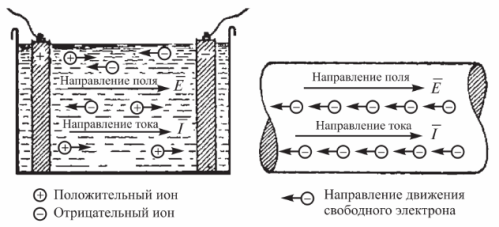
The direction of the electric current in the electrolyte and the free electrons in the conductor
The quantity equal to the ratio of the current to the cross-sectional area S is called the current density: I / S
In this case, it is assumed that the current is uniformly distributed over the cross section of the conductor. Current density in wires is usually measured in A / mm2.
According to the type of carriers of electric charges and the medium of their movement, they are divided into conductive currents and displacement currents... Conductivity is divided into electronic and ionic. For stationary modes, two types of currents are distinguished: direct and alternating.
Transfer of electric shock is called the phenomenon of transfer of electric charges from charged particles or bodies moving in free space.The main type of electric current transfer is the movement in the cavity of elementary charged particles (the movement of free electrons in electron tubes), the movement of free ions in gas discharge devices.
Displacement current (polarization current) called the ordered movement of associated carriers of electric charges. This type of current can be observed in dielectrics.
Total electric current — a scalar value equal to the sum of the electric conduction current, the electric transfer current, and the electric displacement current through the surface under consideration.
Constant is called a current that can change in magnitude, but does not change its sign for an arbitrarily long time. Read more about it here: DC
Magnetizing current — a constant microscopic (ampere) current, which is the reason for the existence of an intrinsic magnetic field of magnetized substances.
Variables called current that periodically changes both in magnitude and sign. The quantity characterizing the alternating current is the frequency (in the SI system it is measured in hertz), in case its strength changes periodically.
A high-frequency alternating current is shifted over the surface of the wire. High-frequency currents are used in mechanical engineering for heat treatment of parts surfaces and welding, in metallurgy for melting metals. Alternating currents are divided into sinusoidal and non-sinusoidal… A sinusoidal current is a current that changes according to a harmonic law:
i = sin wt,
where I am, — peak (highest) current value, Ah,
The rate of change of alternating current is characterized by its frequency, defined as the number of complete repetitive oscillations per unit time.Frequency is denoted by the letter f and is measured in hertz (Hz). So a mains current frequency of 50 Hz corresponds to 50 complete oscillations per second. The angular frequency w is the rate of change of current in radians per second and is related to frequency by a simple relationship:
w = 2pi f
Stationary (fixed) values of direct and alternating currents mean with the capital letter I non-stationary (instantaneous) values - with the letter i. Usually the positive direction of current is the direction of movement of positive charges.
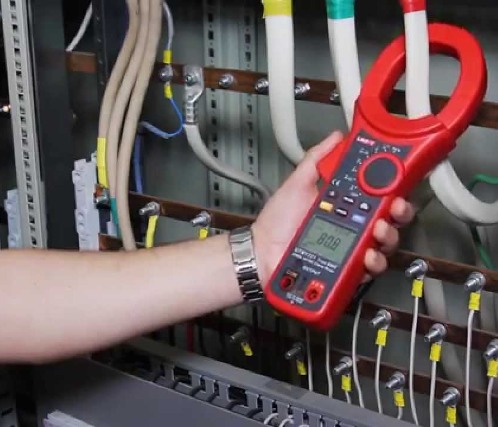
Alternating current It is a current that changes according to the sinusoidal law over time.
Alternating current also means current in conventional single-phase and three-phase networks. In this case, the parameters of the alternating current change according to the harmonic law.
Since AC current changes over time, simple solutions suitable for DC circuits are not directly applicable here. At very high frequencies, charges can oscillate—flow from one place in the circuit to another and back again. In this case, unlike DC circuits, the currents in series-connected wires can be unequal.
Capacitances present in AC circuits enhance this effect. In addition, when the current changes, self-induction effects are felt, which become significant even at low frequencies if high-inductance coils are used.
At relatively low frequencies, the AC circuit can still be calculated using Kirchhoff's ruleswhich, however, must be amended accordingly.
A circuit containing various resistors, inductors and capacitors can be thought of as a generalized resistor, capacitor and inductor connected in series.
Consider the properties of such a circuit connected to a sinusoidal alternating current generator. To formulate the rules for calculating alternating circuits, you need to find the relationship between the voltage drop and the current for each of the components of such a circuit.
Condenser plays completely different roles in AC and DC circuits. If, for example, an electrochemical cell is connected to the circuit, then the capacitor will begin to chargeuntil the voltage in it becomes equal to the emf of the element. Then charging will stop and the current will drop to zero.
If the circuit is connected to an alternator, then in one half-cycle, electrons will flow from the left plate of the capacitor and accumulate on the right, and in the other - vice versa.
These moving electrons constitute an alternating current whose strength is equal on both sides of the capacitor. As long as the AC frequency is not very high, the current through the resistor and the inductor is also the same.
In devices consuming alternating current, the alternating current is often rectified rectifiers to obtain direct current.
Conductors for electric current
Electric current in all its forms is a kinetic phenomenon, analogous to the flow of fluids in closed hydraulic systems. By analogy, the process of current movement is called «flow» (current flows).
The material in which the current flows is called conductor… Some materials go into superconductivity at low temperatures. In this state, they show almost no resistance to current, their resistance tends to zero.
In all other cases, the conductor resists the flow of current, and as a result, part of the energy of the electric particles is converted into heat.The amperage can be calculated by Ohm's Law for the cross section of the circuit and Ohm's law for the entire circuit.
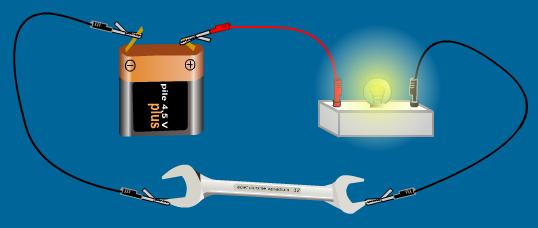
The speed of movement of particles in wires depends on the material of the wire, the mass and charge of the particle, the temperature of the environment, the applied potential difference and is much smaller than the speed of light. However, the speed of propagation of the electric current itself is equal to the speed of light in a given medium, that is, the speed of propagation of the front of an electromagnetic wave.
How electricity affects the human body
Current passed through the human or animal body can cause electric burns, fibrillation or death. On the other hand, electric current is used in intensive care, to treat mental illnesses, especially depression, electrical stimulation of certain areas of the brain is used to treat diseases such as Parkinson's disease and epilepsy, a pacemaker that stimulates a heart muscle with pulsed current is used for bradycardia. In humans and animals, current is used to transmit nerve impulses.
For safety reasons, the minimum receptive current for a person is 1 mA. The current becomes dangerous to a person's life starting from a strength of about 0.01 A. The current becomes lethal to a person starting from a strength of about 0.1 A. A voltage of less than 42 V is considered safe.

